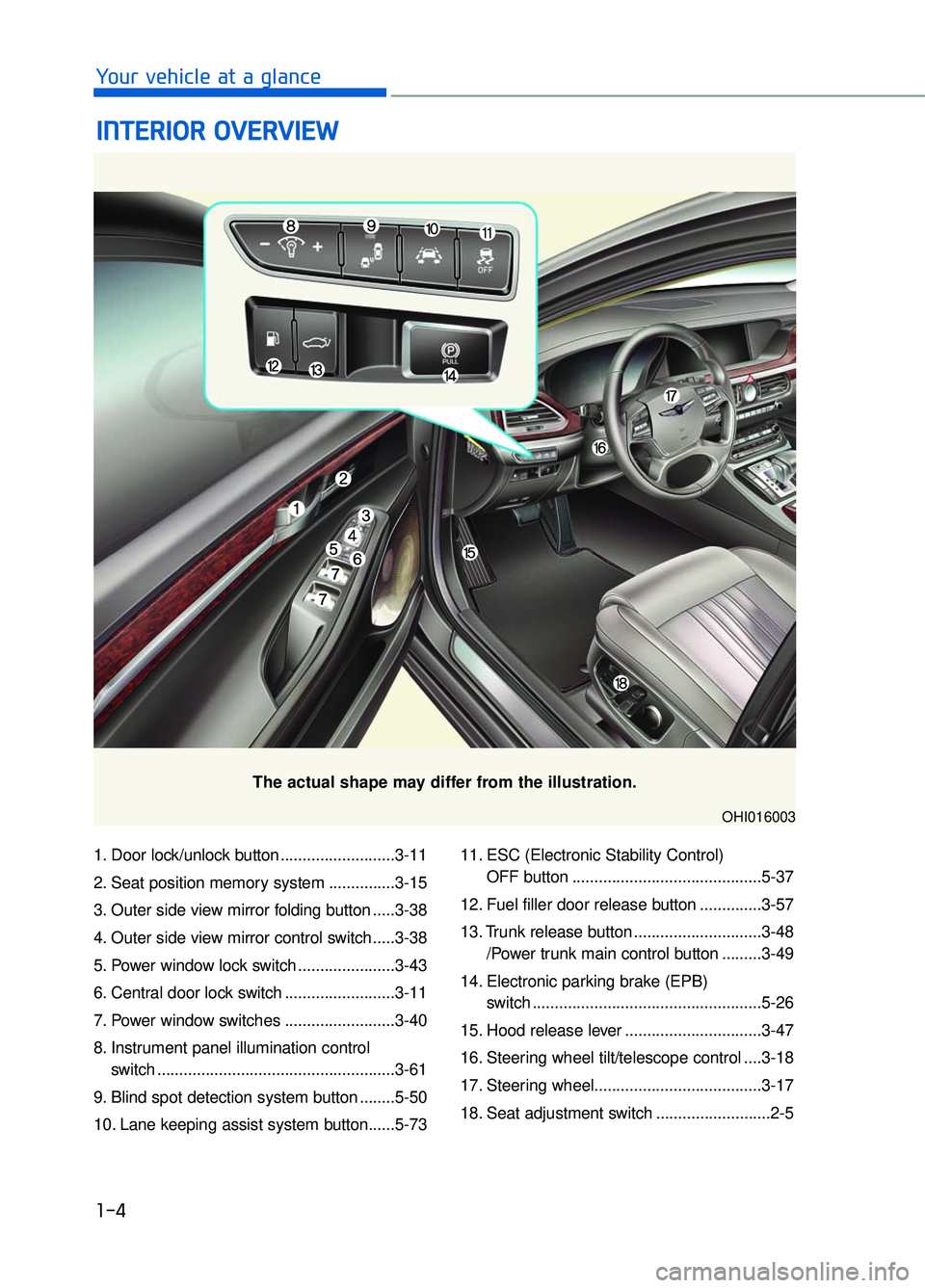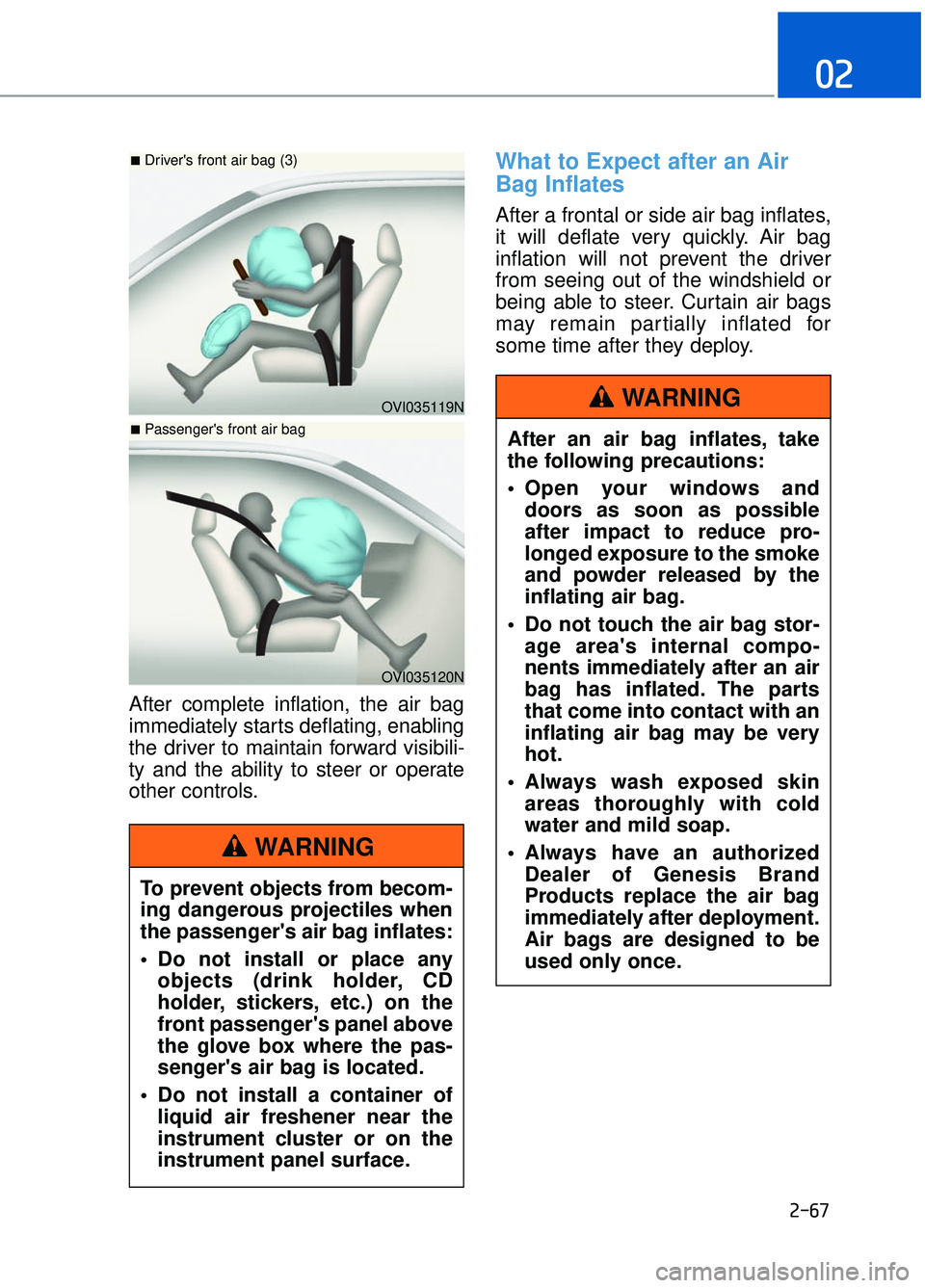2017 GENESIS G90 instrument panel
[x] Cancel search: instrument panelPage 14 of 524

Y
Yo
ou
ur
r
v
v e
e h
h i
ic
c l
le
e
a
a t
t
a
a
g
g l
la
a n
n c
ce
e
Exterior Overview (Front) ..........................................................1-2
Exterior Overview (Rear)............................................................1-3
Interior Overview ........................................................................\
.1-4
Instrument Panel Overview (l) ...................................................1-5
Instrument Panel Overview (ll) ..................................................1-6
Engine Compartment ...................................................................1-7
1
Page 17 of 524

1. Door lock/unlock button ..........................3-11
2. Seat position memory system ...............3-15
3. Outer side view mirror folding button .....3-38
4. Outer side view mirror control switch .....3-38
5. Power window lock switch ......................3-43
6. Central door lock switch .........................3-11
7. Power window switches .........................3-40
8. Instrument panel illumination control switch ......................................................3-61
9. Blind spot detection system button ........5-50
10. Lane keeping assist system button......5-73 11. ESC (Electronic Stability Control)
OFF button ...........................................5-37
12. Fuel filler door release button ..............3-57
13. Trunk release button .............................3-48 /Power trunk main control button .........3-49
14. Electronic parking brake (EPB) switch ....................................................5-26
15. Hood release lever ...............................3-47
16. Steering wheel tilt/telescope control ....3-18
17. Steering wheel......................................3-17
18. Seat adjustment switch ..........................2-5
I I N
N T
TE
ER
R I
IO
O R
R
O
O V
VE
ER
R V
V I
IE
E W
W
1-4
Your vehicle at a glance
The actual shape may differ from the illustration.
OHI016003
Page 18 of 524

1. Instrument cluster ...................................3-60
2. Horn ........................................................3-19
3. Driver’s front air bag ...............................2-59
4. Engine Start/Stop button ..........................5-7
5. DIS navigation system .............................4-4
6. Climate control system.........................3-141
7. Clock .....................................................3-151
8. Hazard warning flasher ............................6-2
9. Passenger’s front air bag .......................2-59
10. Driver’s knee air bag ............................2-59
11. Glove box ...........................................3-14412. Automatic transmission ........................5-11
13. Multi-view camera system..................3-116
14. Parking assist system ........................3-117
15. Auto hold ..............................................5-31
16. Drive mode integrated control
system ..................................................5-44
17. Seat warmers and coolers ...................2-28
18. Heated steering wheel button ..............3-18
19. Rear curtain folding button .................3-153
20. Center control panel ...............................4-4
21. Center console storage ......................3-143
I I N
N S
ST
T R
R U
U M
M E
EN
N T
T
P
P A
A N
N E
EL
L
O
O V
VE
ER
R V
V I
IE
E W
W
(
( I
I)
)
1-5
01
The actual shape may differ from the illustration.
OHI016004
Page 28 of 524

2-8
Safety system of your vehicle
Seat belts
Always fasten your seat belt before
starting any trip.
At all times, passengers should sit
upright and be properly restrained.
Infants and small children must be
restrained in appropriate child restraint
systems. Adults and children who
have outgrown a booster seat must be
restrained using the seat belts.
Front Seats
The front seat can be adjusted by
using the switches located on the
outside of the seat cushion. Before
driving, adjust the seat to the proper
position so that you can easily con-
trol the steering wheel, foot pedals
and controls on the instrument panel.
Take the following precautions
when adjusting your seat belt:
NEVER use one seat belt for more than one occupant.
Always position the seatback upright with the lap portion of
the seat belt snug and low
across the hips.
NEVER allow children or small infants to ride in a pas-
senger's lap.
Do not route the seat belt across your neck, across
sharp edges, or reroute the
shoulder strap away from
your body.
Do not allow the seat belt to become caught or jammed.
WARNINGTake the following precautions
when adjusting your seat:
NEVER attempt to adjust theseat while the vehicle is mov-
ing. The seat could respond
with unexpected movement
and may cause loss of vehicle
control resulting in an acci-
dent.
Do not place anything under the front seats. Loose objects
in the driver's foot area could
interfere with the operation of
the foot pedals, causing an
accident.
Do not allow anything to inter- fere with the normal position
and proper locking of the
seatback.
Do not place a cigarette lighter on the floor or seat.
When you operate the seat,
gas may exit out of the lighter
causing a fire.
Use extreme caution when picking small objects trapped
under the seats or between
the seat and the center con-
sole. Your hands might be cut
or injured by the sharp edges
of the seat mechanism.
WARNING
Page 59 of 524

2-39
02
Body work on the front area of the
vehicle may damage the pre-ten-
sioner seat belt (retractor pre-ten-
sioner seat belt and emergency
fastening device) system.The Pre-Tensioner Seat Belt System
consists mainly of the following com-
ponents. Their locations are shown in
the illustration above:
1. SRS air bag warning light
2. Retractor pre-tensioner
3. SRS control module
4. Emergency Fastening Device
System
Information
The sensor that activates the SRS air
bag is connected with the pre–tension-
er seat belts. The SRS air bag warning
light on the instrument panel will illu-
minate for approximately 6 seconds
after the engine Start/Stop button in
the ON position, and then it should
turn off.
If the pre-tensioner is not working
properly, the warning light will illumi-
nate even if the SRS air bag is not mal-
functioning. If the warning light does
not illuminate, stays illuminated or
illuminates when the vehicle is being
driven, have an authorized Dealer of
Genesis Brand Products inspect the
pre-tensioner seat belts and SRS air
bags as soon as possible.
i
NOTICE
(Continued)
Always replace your pre-ten-sioners after activation or an
accident.
NEVER inspect, service, repair or replace the pre-tensioners
yourself. This must be done by
an authorized Dealer of
Genesis Brand Products.
Do not hit the seat belt assem- blies.
Do not touch the pre-tensioner
seat belt assemblies for several
minutes after they have been
activated. When the pre-ten-
sioner seat belt mechanism
deploys during a collision, the
pre-tensioners become hot and
can burn you.
WARNING
OLMB033040/Q
Page 80 of 524

2-60
Safety system of your vehicle
The purpose of the SRS is to provide
the vehicle's driver and front passen-
gers with additional protection than
that offered by the seat belt system
alone. The SRS uses sensors to
gather information about the driver’s
and front passenger's seat belt
usage and impact severity.
The seat belt buckle sensors deter-
mine if the driver and front passen-
ger's seat belts are fastened. These
sensors provide the ability to control
the SRS deployment based on
whether or not the seat belts are fas-
tened, and how severe the impact is.
The advanced SRS offers the ability
to control the air bag inflation within
two levels. A first stage level is pro-
vided for moderate-severity impacts.
A second stage level is provided for
more severe impacts.
According to the impact severity, and
seat belt usage, the SRS Control
Module (SRSCM) controls the air
bag inflation. Failure to properly wear
seat belts can increase the risk or
severity of injury in an accident. To reduce the risk of serious
injury or death from an inflating
front air bags, take the following
precautions:
Seat belts must be worn at all
times to help keep occupants
positioned properly.
Move your seat as far back as possible from front air bags,
while still maintaining control
of the vehicle.
Never lean against the door or center console.
Do not allow the front passen- ger to place their feet or legs
on the dashboard.
No objects should be placed over or near the air bag mod-
ules on the steering wheel,
instrument panel, and the
front passenger's panel above
the glove box. Such objects
could cause harm if the vehi-
cle is in a crash severe
enough to cause the air bags
to deploy.
WARNING
Page 84 of 524

2-64
Safety system of your vehicle
The SRSCM (Supplemental Restraint
System Control Module) continually
monitors all SRS components while
the Engine Start/Stop button is in the
ON position to determine if a crash
impact is severe enough to require air
bag deployment or pre-tensioner seat
belt deployment.
SRS warning light
The SRS (Supplement Restraint
System) air bag warning light on the
instrument panel displays the air bag
symbol depicted in the illustration.
The system checks the air bag elec-
trical system for malfunctions. The
light indicates that there is a potential
malfunction with your air bag system,
which could include your side and
curtain air bags used for rollover pro-
tection.
If your SRS malfunctions, the
air bag may not inflate properly
during an accident increasing
the risk of serious injury or
death.
If any of the following condi-
tions occur, your SRS is mal-
functioning:
The light does not turn on for approximately six seconds
when the engine Start/Stop
button is in the ON position.
The light stays on after illumi- nating for approximately six
seconds.
The light comes on while the vehicle is in motion.
The light blinks when the engine is running.
Have an authorized Dealer of
Genesis Brand Products
inspect the SRS as soon as
possible if any of these condi-
tions occur.
WARNING
Page 87 of 524

2-67
02
After complete inflation, the air bag
immediately starts deflating, enabling
the driver to maintain forward visibili-
ty and the ability to steer or operate
other controls.
What to Expect after an Air
Bag Inflates
After a frontal or side air bag inflates,
it will deflate very quickly. Air bag
inflation will not prevent the driver
from seeing out of the windshield or
being able to steer. Curtain air bags
may remain partially inflated for
some time after they deploy.
OVI035119N
■Driver's front air bag (3)
OVI035120N
■Passenger's front air bag
To prevent objects from becom-
ing dangerous projectiles when
the passenger's air bag inflates:
• Do not install or place anyobjects (drink holder, CD
holder, stickers, etc.) on the
front passenger's panel above
the glove box where the pas-
senger's air bag is located.
Do not install a container of liquid air freshener near the
instrument cluster or on the
instrument panel surface.
WARNING
After an air bag inflates, take
the following precautions:
Open your windows anddoors as soon as possible
after impact to reduce pro-
longed exposure to the smoke
and powder released by the
inflating air bag.
Do not touch the air bag stor- age area's internal compo-
nents immediately after an air
bag has inflated. The parts
that come into contact with an
inflating air bag may be very
hot.
Always wash exposed skin areas thoroughly with cold
water and mild soap.
Always have an authorized Dealer of Genesis Brand
Products replace the air bag
immediately after deployment.
Air bags are designed to be
used only once.
WARNING